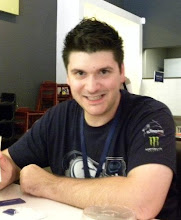Review 4: Ghost Squad - Your mission, SEGA, was to create a lousy Wii cash in using absolutely none of the horsepower or ingenuity of the console. At this mission, you have succeeded brillantly...

Oh man. There are so many of these games for the Wii that I'm getting sick of reading about them and even sicker of playing them. Publishers have discovered a formula which they seem to be using more and more often to squeeze $$ out of the Wii's expanding userbase:
- Dig into your company code archives.
- Find something that can be ported quickly and dirtily.
- Tack on some waggle.
- Profit!
I knew the time would come sooner or later when I'd take one of these "quickies" to task and actually post a (scathing) review. That time, unfortunately for publisher Sega, is now. And I'm sorry for picking on Sega, but as a publisher known for putting out some gems lately, you have to be held accountable when you churn out the turds. First you rush a HORRIBLY buggy Sonic The Hedgehog next-gen title out for 360 and PS3, and then you drop this turd-of-a-game on the completely undeserving userbase of the Wii. For shame, Sega. For shame... I expect this from Ubisoft, Activision, and THQ, but not from you...
At its heart, the concept of Ghost Squad is simple. It takes an arcade light-gun shooter, adds a few extras and party games, and brings the package home at a bargain price. However, there is very little content for the money here, and what is provided is so ridiculously sub-par that I could barely tolerate the game for longer than the hour it took to blaze through the provided 3 missions. After playing the (much better) Resident Evil: Umbrella Chronicles, this game seems unfinished in comparison, even taking into consideration its status as an arcade port.
I guess first I'll start with the positives. First, for a light-gun shooter, the control with the Wii-mote fits perfectly. You point, you shoot, terrorists die. It's not hard, and fairly well-implemented. The cursor sensitivity settings are decent, and it's easy to hit your marks. There are a lot of unlockable costumes and other goodies, but the main game is so disgustingly sub-par that it would take someone with a lot of patience to push through and unlock them all. Same is true for the branching paths in the levels. Depending on your choices as well as how well you perform in timed "action events" (little minigames ranging from eliminating a certain number of enemies with a sniper rifle to diffusing bombs) the path through each stage will differ. Again, if you are a completionist and MUST see every part of the three graphical nightmares the game calls "stages", you'll be playing for quite a while.
Where this game falls apart is in production values and extras. Given that the game was developed by Virtua Fighter gurus AM2, I expected it would at least showcase more of what the Wii can do. At the very least, a slight update of the original arcade game's graphics - like Namco did with Time Crisis II for PS2 - would have sufficed. Unfortunately, Sega would have none of that here. What they gave us is a bare-bones arcade port, with graphics that look like an early PS2 game. Jaggies and muddy textures galore, and even SLOWDOWN when more than 3 characters are on the screen at once. This is COMPLETELY unforgivable when dealing with a game of this type (light-gun games generally relied on their graphics to draw players in), and makes the entire product look disgustingly rushed. The game offers unlimited continues, so it's pretty easy to beat all 3 missions in one setting (though you can actually FAIL the last mission and end your game prematurely by messing up an action event). The voice acting is typical light gun game fare (in that it's horrible to the point of being funny), but neither helps nor hinders the game itself. Music is fairly forgettable.
As I mentioned before, there are quite a few extras thrown in, such as unlockable costumes and party games. But honestly, good thing this is a budget game, because it's going to be extremely difficult for any hardcore gamer to see past this game's shortcomings in both length and graphics. I'm hoping this team is NOT in charge of the upcoming House of the Dead 2 and 3 Return ports for Wii. As they are both better games at their core than Ghost Squad, I still have faith in you, Sega... Don't let me down again.
Rating System: Who needs stars and numbers? I'm all about the otaku emoticons!
*-* = Amazing
^-^ = Good
-_- = Fair
T_T = Poor
Graphics: T_T
Disgustingly hideous, some of the worst I've seen on Wii. From the muddy textures and jaggies to the slowdown present in many cutscenes, this was a blatant rush-job. The code ported from the arcade version seemed to be "dumbed down" for a console that is blatantly more powerful than the arcade hardware originally running the game. This is unforgivable, and sadly, only one of many games that is taking the "we don't have to do graphics because it's the Wii" route. One positive: I noticed a lot of objects in the environments were destructible, which was a nice touch.
Sound: -_-
Hilariously bad voice acting complements forgettable arcade music. Really nothing else to say here...it gets the job done, for an arcade game. Nothing really stands out as either good or bad. The dialogue can be unintentionally funny at times.
Fun Factor: T_T














